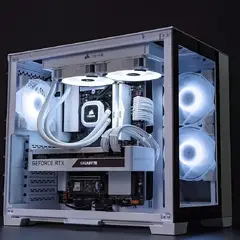How do I dual boot Windows 10 and 7, on completely separate drives in 2018?
On 12/5/2018 at 11:11 PM, documnt said:Usually motherboards support a boot option like F8/F12 where you can specify the drive you want to boot from.
On 12/5/2018 at 11:23 PM, .Ocean said:I have a friend who does this by swapping drives whenever he wants to use a different os. That isn't ideal though and I know from personal experience that windows hates getting along with other drives. With that being said. I have a SSD and a HDD, the SSD has windows 10 while the HDD has windows 7. I never boot from the HDD but I still grab files off of it. I just installed the related version of windows normally to each drive, no errors encountered.
On 12/5/2018 at 11:31 PM, NumLock21 said:Just use your Bios boot order to select the drive you want to boot from, much easier and less problems in the long run.
On 12/5/2018 at 11:37 PM, G27Racer_188 said:I agree with others, use boot override selection menu of your motherboard to switch to OS / drive you want.
I do it that way. Default is Win 8.1 on SSD, and Win 7 on HDD.
None of you have read my post or viewed the links there - this is exactly what I've tried, but it's resulted in this every time, with no bcdedit commands fixing it: 
When the windows 7 installer says it needs to restart to complete the installation, this happens. it happens regardless if I boot from bios boot order, bios manual click, or boot menu. More info in the Reddit posts linked below.
It also caused this in my windows 10 install on the separate drive after many reboots (despite chkdsk  /f reporting "no action required" (the fix error checking)), and other issues (linked below again - they didn't hyperlink in my OP). Presumably because of the incompatibilities between the Windows 10 and 7 boot managers, and the 7 installer messing with the system reserved partitions on my
/f reporting "no action required" (the fix error checking)), and other issues (linked below again - they didn't hyperlink in my OP). Presumably because of the incompatibilities between the Windows 10 and 7 boot managers, and the 7 installer messing with the system reserved partitions on my  windows 10 drive.
windows 10 drive.
From many sources I found that having 10 as the first OS then installing 7, be it on a completely separate drive or not (can confirm in my experience), causes lots of issues since 10 has a newer boot code than 7, and I have no idea why this is an issue despite them being on separate drives, but it is.
My plan is,
1. Reformat the other drive to install 7 on as GPT / UEFI
2. Make a 64GB partition for W7
3. Leave the rest for file use.
4. Redownload and reverify the hash in the Windows 7 ISO (already done)
5. Burn to USB in GPT UEFI mode, with Rufus (already done)
6. to physically unplug my windows 10 C:\ drive,
7. Retry the install, and see if it boots.
PARTIALLY SOLVED FOR NOW:
All I had to do was:
1. Physically unplug my windows 10 drive before doing anything (doing this caused a minor error during Windows 7 install, which means it WAS messing with my 10 partition, solution below)
2. Follow this video CAREFULLY. Link:
BUT IMPORTANTLY:
commands are in bold italic
- right after the clean step, you need to type convert gpt if you want to use a UEFI / GPT (non CSM) install USB stick / wanna use the UEFI bios type of install
- note that the 5GB partition he makes is to copy the install files into it, not to use the OS on. If you want another partition, make another one right after the create partition step, with your desired size. E.g. for 64gb it's
create partition primary size=64000
3. Close the setup so it reboots, then goto the BIOS while it boots, then shutdown to avoid corruption of the USB. Then UNPLUG THE USB
4. Then, boot the pc, go into bios, and select the 5gb partition you just made with install files. It may just show the full disk size, and that's okay, as long as you recognise it. It should be something like "UEFI - SanDisk blah blah blah" if you're using UEFI or just "blah blah blah" if you're using MBR
5. Let the install finish. This worked for me. If it didn't please ask. If this thread is too old pm me. Or make a new thread.
IMPORTANT; I haven't plugged in my normal windows 10 SSD yet, so I haven't got the dual boot aspect done, but 7 itself is working!
Will update later!!
UPDATE: it fully worked. quite happy with the results, no issues on either OS.
Not using EasyBCD because it doesn't like UEFI, and i just used BIOS to boot off the correct drives.
Solved.
If it fails, I have two options from my research, which I'll try consecutively if the previous fails:
1. Run bcdedit commands to fix winload.efi
2. Enable CSM support mode in the BIOS
3. Boot into windows 10, reformat the SSD as MBR then remake a new USB with Rufus for the W7 install media, in MBR mode, and retry the whole thing with Legacy BIOS emulation in my BIOS


















Create an account or sign in to comment
You need to be a member in order to leave a comment
Create an account
Sign up for a new account in our community. It's easy!
Register a new accountSign in
Already have an account? Sign in here.
Sign In Now